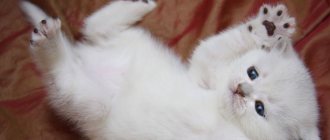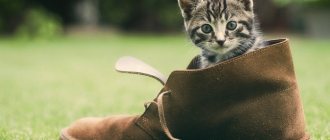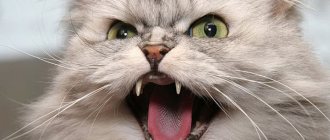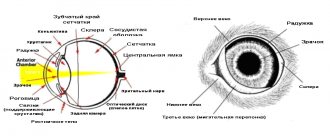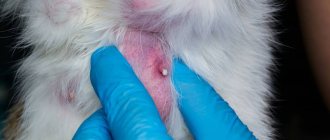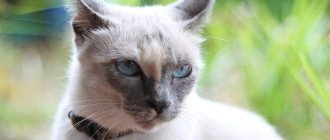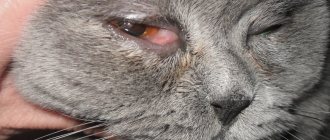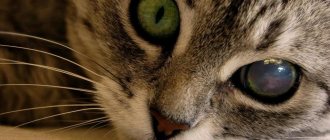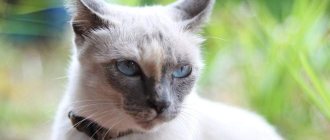12323Pavel
When a cat has a swollen belly, he needs urgent help. This condition is dangerous for the animal, not only by impaired mobility, but also by changes in the functioning of internal organs. In order to carry out timely and competent therapy, it is necessary to immediately accurately determine the cause of the unpleasant phenomenon. This is best done by a veterinarian, and it is he who should be contacted if problems with your pet’s health arise. If a cat's stomach becomes suddenly swollen, the situation requires immediate veterinary attention.
Diagnostic methods
To determine why a cat is not eating and its belly is swollen and hard, your veterinarian must conduct a comprehensive examination of the animal:
- Collection of biomaterial for analysis. Laboratory examination of the blood, urine and feces of a four-legged patient will help to find out whether the animal is infected with parasites. In addition, the specific nature of bowel movements can promptly prompt the doctor that the cat is suffering from tumors of the internal organs.
- Physical examination. Feeling and listening to the cat's abdominal cavity will give the veterinarian an idea of the processes occurring inside, which will make it easier to make a final diagnosis.
- Ultrasound, x-ray. A visual display of the condition of the abdominal cavity will give the physician the most complete picture of the disease.
Only a combination of all the methods described above will allow the veterinarian to determine what exactly the cat is sick with and prescribe appropriate therapy. Despite the similarity of symptoms, not all diseases that cause a hard belly are treated the same.
Changes in muscle tone during pregnancy
In most cases, pregnancy in cats is easy. The cat does not feel any discomfort, but is reluctant to be handled and strains its abdominal muscles when trying to feel it. A very hard belly in a cat may indicate a pathologically developing pregnancy. This condition ends in miscarriage and is accompanied by changes in the pet’s behavior - she refuses to eat, drinks a lot, behaves restlessly and constantly meows. In the early stages, detecting a miscarriage in a cat is problematic, while pregnancy failure in the later stages is accompanied by heavy bleeding.
If your cat has a hard belly after giving birth, you should take the animal to the vet as soon as possible. This is a dangerous sign indicating the development of pyometra. This disease is caused by the penetration of pathogenic bacteria into the uterine cavity. Pyometra is accompanied by profuse suppuration, which can be caused by infection of the uterus during delivery.
Symptoms of a dangerous disease:
- Hard and swollen abdomen.
- Refusal of food.
- Increased thirst.
- Increased body temperature.
- General deterioration in health.
With pyometra, veterinarians insist on surgical removal of the uterus and appendages. A timely detected disease can be successfully treated with antibiotics, but only at the beginning of the development of the pathological process.
Diagnosis and treatment of causes of bloating
An accurate diagnosis must be made by a veterinarian in the clinic. The study requires a general analysis of blood, urine and feces. A general clinical physical examination of the patient is carried out using palpation and auscultation methods.
It is especially important to study the animal’s feces, which makes it possible to confirm or refute the presence of helminths in the intestinal tract. It is necessary to conduct a stool analysis to determine the presence of tumor processes
Accurate diagnosis involves ultrasound examinations of the abdominal organs and radiography, which allows you to get a real picture of what is happening. Treatment of flatulence is based on the established diagnosis and includes some basic points:
- antispasmodics No-shpa and Traumeel (relieving spasms and pain);
- enterosorbents (activated carbon, Polysorb, Smecta);
- probiotics (reducing the risk of formation of putrefactive microflora and restoring the intestines after a course of antibiotics);
- hepatoprotectors (protect liver structures and help normalize protein metabolism).
Diagnosed ascites or peritonitis require immediate surgical intervention. After the surgical procedure, the animal must remain under the supervision of specialists in the hospital for some time. If necessary, the outflow of fluid is regulated by introducing a drainage system. Monitoring the pet’s condition and regulating all vital processes of the patient’s body is important. Antibiotic therapy, anti-inflammatory drugs and some specific medications are prescribed.
If your cat’s stomach bloats periodically after eating, you need to carefully review the diet and choose a more balanced one. Eliminate flour and sweet, dairy and fermented milk products from your diet. A veterinarian should advise medications containing enzymes to improve digestion (if there is such a need and flatulence is associated with enzyme deficiency).
Hematoma at the withers
Often after injections, lumps appear on the skin. This happens in two cases - the injection is placed incorrectly or the injection solution is too thick.
The lump after an injection into the withers of a cat is not dangerous and acts as nothing more than an ordinary hematoma. It resolves after a few days and does not require specific treatment. You should consult a doctor if there is an increase in skin temperature around the lump, and the animal constantly tries to comb the sore area.
Among the reasons for the appearance of bumps on the neck and withers in animals, injuries should also be noted. If an animal walks freely on the street, it can fight with a fellow animal, and a seal forms at the site of the bite. Such an injury is dangerous with the risk of abscess formation, so it should be immediately treated with an antiseptic.
In all other cases, you should not try to treat the cat yourself, or hope that the lump will resolve. Only a specialist can make an accurate diagnosis and relieve the animal of discomfort.
Diagnostics and therapy
To make a diagnosis, blood, urine and feces are examined, ultrasound and x-rays are done. During the examination, the veterinarian palpates and listens to the peritoneum. Depending on the results that explain why the cat has a hard stomach, the doctor decides what to do to normalize his condition.
Help with non-dangerous causes of bloating
Flatulence caused by poor nutrition can be eliminated by adjusting the diet. A ban is imposed on any products that increase gas formation (legumes, flour, fresh vegetables). Remember that milk is contraindicated for adult animals, as they develop lactose intolerance. To normalize intestinal function, your veterinarian may recommend a course of probiotics.
Excessive weight can be eliminated by reviewing your diet. The animal is prescribed less high-calorie food and the usual portions are reduced. Daily physical activity is complemented by joint games.
A big belly in a scared cat can be healed with time. Do not impose your affection and let your pet get used to the unfamiliar environment.
Treatment of the underlying disease
Surgery will be required to eliminate pyometra. During the operation, the veterinarian cuts out the uterus, that is, performs sterilization. Surgeries are also necessary to remove a tumor, intestinal obstruction, foreign object, or the consequences of severe trauma.
All infectious diseases are treated with antibiotics and antiviral drugs, and helminthiasis with anthelmintics. Intoxication with poisons is eliminated by administering an antidote and gastric lavage. In case of ascites, excess fluid is pumped out of the animal and a course of diuretics is prescribed.
To treat constipation, use Vaseline oil or laxatives. Such therapy is permissible only in the absence of intestinal obstruction. Otherwise, taking these drugs may cause intestinal rupture.
Treatment for an abscess depends on its complexity. Most often, drug therapy, which involves taking antibiotics and anti-inflammatory drugs, is sufficient. In case of extensive inflammation, the ulcers are removed by a surgeon.
Cholecystitis is treated with antibiotics and proper nutrition. The animal is transferred to a veterinary food that fights gallstones.
Any therapy must be carried out under the supervision of a veterinarian, with dosages clearly specified by him.
How to cure ascites
If you are told that ascites cannot be treated, do not believe it. You can get rid of abdominal dropsy once and for all, but to do this you need to find the underlying disease. High-quality, in-depth, differential diagnostics will allow you to identify the disease, and then you can begin treatment:
- Symptomatic treatment.
- Treatment of the underlying disease.
- Prevention of complications (diet, etc.).
If you try to remove only the symptoms, the fluid will return to the peritoneum again and again. But you still have to pump out this water (for example, 2 times a week). To do this, they resort to paracentesis (a puncture in the abdominal wall). In addition, the cat will need to be given diuretics. The veterinarian may prescribe some heart medications (if the fluid has disrupted the heart) and medications to improve the functioning of the gastrointestinal tract. In addition, agents that improve blood flow, etc. may be required.
Of course, at the same time the cause of ascites will have to be treated. Complex treatment can save your pet, the main thing is to follow all the veterinarian’s instructions.
Only a veterinarian can prescribe the correct treatment
Medications
Veterinarians often prescribe calcium chloride 10% (intravenously) and vitamin K (intramuscularly) as a vasodilator. Vitamin injection into a muscle is a painful procedure, so if you have to inject drugs at home, enlist the support of your household. If you don't restrain your cat during the injection, she may jerk. After such failures, the animal will experience pain when walking.
To maintain the cardiovascular system, the following drugs are usually prescribed:
- Cardiovalen;
- Olitorizide;
- Strophanthin;
- Korglykon;
- digitalis tincture (regulates the functioning of the heart muscle);
- tincture of lily of the valley (has a cardiotonic effect);
- Digitoxin (Digoxin), etc.
Photo gallery: cardiovascular medications
Digoxin can be found in tablets and ampoules for injection (you need to purchase the medicine in accordance with the recommendation of a veterinarian) Cardiovalen is made on the basis of plant raw materials, and is taken by drop in the mouth, like Corvalol. Some cardiac drugs have a pronounced sedative effect. An analogue of strophanthin is Olitorizide, but they varying degrees of toxicity (check with your veterinarian)
If your cat is diagnosed with an infectious disease, she will most likely be prescribed an antibiotic. Usually these are cephalosporin drugs (Cefamezin, Lizolin, Cephalexin, etc.). They are low toxic, effective and well tolerated by cats. An antibiotic can destroy the causative agent of the infection, which will stop the development of the underlying disease.
With ascites, it is important to regulate the excretion of waste products (especially in the later stages). For this purpose, diuretics and laxatives (for constipation) are usually prescribed:
- Furosemide;
- kidney and liver teas;
- Temisal;
- Indapamide-Verte;
- Novurit;
- bearberry leaf, etc.
Photo gallery: diuretics and laxatives for ascites
Indapamide has many commercial names (you need to choose one prescribed by a veterinarian, since all analogues have different mass fractions of the active substance) Bearberry and birch leaves are strong diuretics of natural origin. An analogue of furosemide is Novurit, which is also sold in the form of suppositories (sometimes rectal administration of the medicine is more convenient)
Herbal teas can also be bought at a regular pharmacy, but you need to choose the one that was prescribed by your veterinarian
The use of medications is very important for the pet's recovery, but the cat must have a thirst for life. A strong, active cat will fight if the owner worries with her, if the animal feels love. However, sometimes this is simply not enough. In order for the cat’s body to resist the disease, immunostimulating agents may be required:
- Gamavit;
- Maxidin;
- Feliferon;
- Amiksin;
- Interferon.
Cats are hyperimmune animals; they have strong immunity by nature, so immunomodulators and immunostimulants can be given only after the recommendation of a veterinarian. I heard that if you give strong immunostimulating drugs to a cat, the animal can be harmed (allegedly, the body may perceive antibodies incorrectly, and because of this, the animal’s native cells may die). Such a strong drug is called Interferon. For a high-quality effect, it is prescribed 5 drops in each nostril (as a rule, it is recommended to drop it 5 times a day for 5 days).
Photo gallery: immunomodulatory drugs
Amiksin is an expensive analogue of Interferon, but it can be bought in a package containing the required number of tablets Gamavit is one of the most affordable immunomodulators for animals, and you can find it in any pet pharmacy
Most veterinary immunomodulators are available without a prescription, but there is no need to abuse them. Feliferon’s formula was developed specifically for cats, so it is most often prescribed
If ascites is just beginning, and its cause is not an acute infectious disease, then it is better not to resort to the use of such drugs at all. The fact is that the veterinarian can look for the cause of ascites for 1-2 weeks (or even longer), but if the owner insists on such a recommendation, the veterinarian may succumb to persuasion. This can cause more harm to the animal than help. Otherwise, all prescribed procedures must be followed until all symptoms disappear.
Diet for ascites
The diet for dropsy should be protein-rich. The diet of a sick cat should be composed of high-quality, low-fat foods:
- meat (beef, chicken or turkey, offal can be temporarily abandoned) - at least 50% of the total diet;
- fish (only sea fish - no more than 2 times a week);
- fermented milk products will help relieve tight intestines (kefir, fermented baked milk, cottage cheese, etc.) - for constipation;
- cereals (rice, buckwheat, etc., except legumes) should be given for diarrhea;
- Vegetables and fruits can be given as desired (but it is still better to focus on meat).
Chicken breasts (boiled and shredded) are the best right now. If you have diarrhea, you can add boiled rice and rice water to them. It’s better if you don’t change food, keep your cat on a “mono-diet”. This will make your stomach easier.
Whisper, forum user
https://forum.mau.ru/viewtopic.php?t=59224&start=0&postdays=0&postorder=asc&highlight=&print=1
A cat suffering from ascites needs protein food
Of course, everything spicy, smoked and salty should be completely excluded. You also need to give up dry food and economy-class wet food. If you feed your pet wet food, you can replace it with more expensive analogues. When my cat got sick, the veterinarian recommended replacing the usual Whiskas with Hills or Purina brand food. Such food contains more healthy than harmful.
It is recommended to steam meat and fish, without adding salt at all (cats eat meat even unleavened). The need for such a diet is due to the fact that protein is a source of strength and energy (a sick cat could use strength). In addition, high-calorie foods can be given in smaller quantities, which means less water will enter the body. Some owners whose cats are prescribed diuretics want to speed up the process of getting rid of a round cat belly, some even completely exclude water from the diet. However, this is not entirely the right solution. It is also impossible to avoid liquids completely, especially if the cat has diarrhea or vomiting (there may be dehydration).
Strict diet - no salt, protein needed. You know, he could barely walk, he was lethargic, he was feeding from a syringe. But now he is on the mend, his appetite has returned, and he goes to the toilet more often. I give decoctions tablets to wash down, which drive the liquid.
Olesya, forum user
https://www.woman.ru/home/animal/thread/4903122/
Traditional methods of treatment
Some cat owners choose traditional medicine
Sometimes unforeseen circumstances occur that do not allow you to take the animal to the clinic (or call a veterinarian); in such cases, you can resort to folk remedies. And there are cat breeders who fundamentally refuse “chemistry”. They believe that natural herbs are not capable of harming a pet, but plants have miraculous powers. Such people use only plant materials to treat ascites:
- prince of Siberia;
- yellow bedstraw;
- calamus roots;
- birch leaves and buds;
- European hoof;
- angelica and steelhead;
- gorse;
- cinquefoil
I heard about a recipe for birch tea. You just need to brew the dry leaves in boiling water, like tea (1:10). In the same jar you need to add baking soda (2 grams per 1 cup of boiling water). The broth should stand for at least 6 hours, then it can be strained. The cat is given this tea twice: in the morning or in the evening. Soda gives the broth an unpleasant aftertaste, so the animal will not drink much of it, but you can pour a teaspoon into your pet’s mouth. But this tea is good for getting rid of the tummy itself, and the underlying disease needs to be treated separately.
According to one of the folk recipes, birch tea is a good diuretic.
You can make a herbal mixture from princeling, birch buds, gorse and bedstraw. Pour two tablespoons of this mixture with boiling water (500 ml), leave in a water bath (half an hour) and strain. The cat should be given this decoction a teaspoon several times a day (for example, 5-6 times). And according to another folk recipe, you can make a collection of steelweed, cinquefoil, calamus root and angelica. It must be poured in the same proportions, but instead of a water bath, the collection must be boiled (over low heat for a quarter of an hour). You can give this decoction in the same way as the first collection.
Treatment of ascites in kittens
It is believed that kittens are not susceptible to the phenomenon of ascites. A kitten is considered a cat under the age of 1 year. However, veterinarians note that most of these ailments occur between the ages of 6 months and 2 years (cats older than 10 years are not taken into account). The most common age for hydrops is 10 months. At this time, cats and cats already look like adults.
There is an assumption that immunity to such diseases is associated with the age of the animal. There is another assumption - that ascites may occur in connection with hereditary diseases.
Kittens also have ascites, but this phenomenon is rare.
Treatment for kittens is the same as for adult animals, but the dosage of medications will be slightly different. There is only one exception - it is not recommended to give immunomodulators to kittens. The cat’s small organism must learn to determine for itself where its cells are and where they are foreign. If you neglect this rule, the kitten’s immunity will not be able to develop normally (even after recovery).
About 3 weeks ago, my appetite began to worsen (the kitten is on a natural diet) and my stomach somehow began to enlarge. About a week ago, when exhaling, sounds like a clogged nose sometimes began to be heard (but not all the time). The appetite is normal, but he gets tired of playing quickly. Today we took him to the vet. The temperature was: 40.5. ASCITIS was determined. Infectious peritonitis was excluded. They did an ultrasound - everything was normal. The cardiogram showed heart failure.
Ami, forum user
https://mauforum.ru/viewtopic.php?f=36&t=5652&start=50&view=print
Foods that cause flatulence in cats
Considering that in 90% of cases, flatulence is a consequence of poor nutrition, let’s consider foods that are at risk. If you have already encountered a problem, it is recommended to disassemble the diet “piece by piece” and, using the method of elimination, identify the product that is not digestible. Each organism is individual; if, after excluding obviously harmful products, the accumulation of gases bothers the cat, then we include everything in the “circle of suspects,” even meat.
In general, in order to reduce the risk of diseases of the digestive tract to a minimum, it is necessary to create a diet close to the “wild” way of life. Let's look at foods that are not typical for an adult cat:
Milk and dairy products - no matter how strange it may sound, some cats cannot digest the product due to lactose intolerance. In nature, a cat receives milk only from its mother, and when it grows up, it eats exclusively meat. However, if your pet tolerates milk or “live” yogurt well, go ahead, it is a source of many beneficial substances and friendly bacteria.
Fish - again, breaking stereotypes. Cats are not adapted to fishing in nature. If you manage to enjoy river fish at least occasionally, then there is no question of ocean fish. Tuna, sprat, herring, raw goby are delicacies that are allowed rarely and in very limited quantities. With daily feeding of fish, disturbances in the functioning of the central nervous system and kidney failure are possible due to an excess of phosphorus.
Cereals – feeding your pet soybean or wheat, corn, barley, semolina “porridge” is the first cause of flatulence. Gluten and large amounts of carbohydrates are an excellent source of food for bacteria. Of the grains, rice and buckwheat are recommended for cats. Bread is a cereal product and also contains yeast (big fans of releasing gases), so it is also not recommended for “muchriki”.
Garlic, onions, fatty, fried, spicy foods, expired foods and cheap industrial feeds irritate the intestinal walls. The inflamed intestinal mucosa is unable to support beneficial bacteria and “gas” bacteria take their place.
Preventive actions
To prevent the pet from encountering a problem such as bloating, its owner must take care of the prevention of diseases that cause this symptom. The most effective protective measures in this case are:
- The right diet. A consultation with a veterinarian will allow you to select a diet taking into account the age, health status and individual needs of a particular cat. Its owner will only have to make sure that the animal does not overeat and always has access to drinking water and does not receive poorly cooked meat or fish (such products may contain parasites).
- Insulation. An animal that is constantly in the apartment has less chance of contracting an infection or picking up worms. Lack of contact with other cats and walks in the fresh air will not harm your pet (unlike open windows, through which disease carriers - insects - can enter the house, and the pet itself can jump out and get injured by landing carelessly on the ground).
- Special medications. Anyone, even a domestic animal, must undergo preventive treatment for worms once every 3 months. For this purpose, special tablets are sold in pharmacies. Vaccinations against common cat infections are done less frequently - once a year.
Source
Causes of the condition
Non-pathological factors
Cats can pass gas not only because of health problems; there are also harmless reasons, for example, an incorrect diet. It is not recommended to give adult animals milk, bread, or fatty foods. In addition, the fish that owners are accustomed to feeding their pets is poorly absorbed by their bodies, so it is given in limited quantities. You should not feed cats sweets, sausages or smoked meats.
Under normal conditions, when eating food, the animal swallows a small amount of air, but it is so minimal that it does not affect digestion. However, sometimes cats take large gulps of air, which is called aerophagia in veterinary medicine. It is observed when a cat eats too large pieces of food, salty foods, or foods that have an excessively high or low temperature. This condition does not require treatment. Owners only need to give their cat small pieces of food at room temperature.
Pathological factors
Flatulence can also be due to the following reasons:
This condition is typical for animals that have parasites.
- Worm infestation. When a pet is infected with worms, rumbling in the stomach, attacks of nausea and vomiting, and diarrhea are observed. Cats pass gas and their tummy is swollen. If the owners do not notice the problem in time, helminthic infection sometimes leads to death, since serious intoxication of the body is observed.
- Peritonitis. It is considered one of the most life-threatening factors for a cat when flatulence occurs. Pathology can be triggered by a number of factors, including coronavirus, which cannot be treated and leads to death.
- Ascites. During this disease, a large amount of fluid accumulates in the abdominal cavity, which causes flatulence. The kitten's stomach growls strongly, while the appetite decreases, and the animal becomes weak.
- Neoplasms. Flatulence is sometimes triggered by the presence of malignant and benign tumors in the peritoneal area. Owners in such a situation may notice that the pet develops diarrhea, exhaustion, and vomiting.
- Constipation. It can be caused by various factors, but is often associated with an improper diet or the presence of worms in the body. At the same time, not only feces, but also gases do not pass through the intestines.
- Plague. The disease is caused by parvovirus. In addition to flatulence, animals experience increased body temperature, diarrhea, vomiting, and loss of appetite. The disease is mainly diagnosed in kittens.
When is self-medication possible?
It is possible to treat bloating in a cat without involving a veterinarian only if there is simple flatulence in which there is no manifestation of any other disease. In other cases, an immediate visit to a veterinary clinic is necessary. Answering the question of what to do if a cat’s stomach is swollen, we can advise the following :
- Hilak Forte - Give 1 drop per 1 kg of weight once a day, until complete recovery;
- Smecta;
- Enterosgel;
- Children's espumesan.
All 3 drugs are selected in a dosage that is calculated based on the weight of the pet.
A bloated belly in a cat is a dangerous condition and its cause must be identified. This is often a symptom of a serious injury. The problem should be resolved with the involvement of a veterinarian. If the cat begins to bloat before our eyes, and there is no urinary retention, it is necessary to give medication for allergies, since this is most likely it. As soon as the attack subsides, the size of the abdomen will return back, and everything will be normal.
Breed characteristics
Some cat breeds are characterized by the obligatory presence of a fat tail (a genetically determined trait), these include:
| Cat breed | Phenotype feature |
| Hairless cats | No fur |
| Sphinx (Canadian, Egyptian) | Straight ears |
| Bambino | Shortened paws |
| Elf | Ears turned back |
| Ukrainian Levkoy | The tips of the ears are rounded inward |
| Cohona | Round ears, many folds |
| Peterbald | Large long ears, narrow muzzle (like Orientals) |
| Britons or British Shorthair cats ("blue blood") | Flat muzzle, voluminous cheeks, predominantly yellow eyes, short harsh coat, plush appearance, deep gray color |
| Scottish cats: Scottish Fold (low-eared) and Scottish Straight (straight-eared) | Flat muzzle, soft short fur of various colors, predominantly yellow eyes, ears may be straight, partially flattened or lying on the head |
| Savannah | Large spotted cat, hybrid with wild breeds |
| Chausie (housey) | Large (up to 15 kg) wild-colored cats with thick, dense, short hair |
| Cornish Rex | Short wavy coat |
| Bengal cat | Complexly colored spotted fur (leopard-like) |
| Kanaani | Tassels on large ears, spotted color |
The breeds listed above also have some characteristics. For example, the Scots: not all representatives have a hanging belly, but only the European line (and this feature is clearly noticeable in small kittens).
Bambino cats Elf cat Peterbald cat
British cat
Scottish cat
Chausie cat Bengal cat
Among the Canadian Sphynxes, the appearance of a pronounced belly after castration of cats is considered the norm, which adds some charm to them and touches the owners.
Important! Hairless breed cats require special care for skin folds throughout the body (wipe with wet wipes) due to the increased oiliness of the skin.
All British cats have a hanging belly from an early age and this should not frighten new owners. A fold of fat between the hind legs is not a flaw in the appearance of show animals; experts do not pay attention to it at shows. Even in British cats of thin build, the fat tail stands out clearly.
Symptoms of hydrothorax: how to recognize the disease in your pet?
The first thing you need to pay attention to is your pet’s behavior. With hydrothorax, shortness of breath gradually develops, body temperature remains normal, but due to internal changes, the mucous membranes become bluish (cyanosis)
When palpating the chest area, there is no pain, but there is swelling.
One of the features of hydrothorax is its stages. Periods of exacerbation may be followed by temporary relief. However, don’t mistake this for recovery! Remember that hydrothorax in cats requires professional veterinary treatment.
Signs of hydrothorax (dropsy) in cats:
- general weakness,
- fast fatiguability,
- increasing shortness of breath,
- appetite disorders,
- cyanosis of the mucous membranes (pressure restores the natural color),
- swelling in the perineum, chest, eye area and paws.
A cat suffering from dropsy loses the desire to play. She spends more time in solitude, has virtually no contact with people, and does not go into arms. With hydrothorax, animals lie down with their paws widely spread forward and their heads stretched upward. Breathing becomes heavier (long inhalation and short exhalation).
Our doctors
Moiseeva Irina Vladimirovna Pain treatment specialist, neurologist Experience 16 years Make an appointment
Zasov Evgeniy Yuryevich Pain treatment specialist, neurologist Experience 6 years Make an appointment
Smirnova Natalya Valerievna Pain treatment specialist, neurologist Experience 8 years Make an appointment
Voloshin Alexey Grigorievich Pain treatment specialist, anesthesiologist-resuscitator, head of the Pain Clinic, Candidate of Medical Sciences 18 years of experience Make an appointment
Polonskaya Natalia Mikhailovna Neurologist Experience 18 years Make an appointment
Clinical picture
The initial stage of the pathological condition is virtually asymptomatic, since the accumulation of fluid in the abdominal cavity is a gradual process. Characteristic signs can only be noticed when the volume of fluid exceeds normal levels. Ascites can be suspected by a noticeably swollen abdomen and stretching of the sides when the animal is active.
Symptoms:
- the abdominal cavity is swollen, hard to the touch;
- fluctuation - when pressing on the abdomen, you can feel the liquid inside it swaying;
- the belly takes on the shape of a pear when the cat stands on its hind legs, and inflates and rounds when taking a sitting position;
- dullness and disheveled fur;
- yellowish tint of mucous membranes;
- paws, ears, crotch, sternum swell;
- vomiting, nausea;
- lack of appetite;
- constipation or diarrhea;
- breathing problems, hoarseness, shortness of breath;
- weakness, apathy.
It is very important to distinguish ascites from ordinary overeating
Forecasts
The main prognostic factor is the size of the tumor: the median life expectancy of animals operated on with tumors larger than 3 cm is 4-12 months; 2-3 cm – 15-24 months; up to 2 cm – more than 3 years.
In a study combining surgery and chemotherapy, the median survival time after bilateral mastectomy and chemotherapy was 917 days, and after unilateral mastectomy and chemotherapy it was 348 days.
More sparing operations often lead to local recurrence, tumor invasion and distant metastasis.
Simultaneous OGE does not improve cancer prognosis.
Presence of metastases detected in the lungs – 5 months. Reactive lu - up to a year.
Chemotherapy with doxorubicin significantly increases median life expectancy. Most studies suggest that surgery and additional chemotherapy are better than chemotherapy alone. Single-mode surgery does not affect the course of the oncological process at all in the presence of metastases.
Varieties of frontitis
Types of frontal sinusitis vary depending on the route of infection, the type and time of development of the pathology.
Experts distinguish:
- Acute frontal sinusitis. It is characterized by the sudden onset of an inflammatory process, the development is rapid, and the end of the disease is complete.
- Chronic frontal sinusitis. Occurs as a consequence of a poorly treated acute form of the disease; with it, long periods of exacerbation are replaced by short pauses of easing symptoms.
- Allergic frontal sinusitis. Immediate reaction to allergens: frequent sneezing, itching of the nose and eyes, there may be no increase in temperature or it may be low;
- Viral frontal sinusitis. When exposed to the virus, a rapid rise in temperature begins, complaints of sore throat, sneezing, and liquid translucent mucus appears.
- Bacterial frontitis. During a bacterial attack, the temperature rises, but slowly; the patient does not sneeze, and the mucus forms thick, with a characteristic tint.
- Catarrhal frontitis. It manifests itself with heaviness in the frontal region, nasal congestion; may not cause complications, or may progress to a more acute stage.
- Purulent frontal sinusitis. The formation and accumulation of purulent contents in the frontal sinuses has a detrimental effect on the patient’s condition; Even loss of consciousness is possible.
- Pneumosinus. A special form of frontal sinusitis, which is characterized by stretching of the frontal sinus; at the same time, air enters the sinus, but there is no exit for it. In this case, there may be no inflammation, but pain in the frontal region will be felt.
Regardless of the type of sinusitis, it can affect either one sinus (right or left) or be bilateral, when both sinuses are involved in the inflammatory process.
